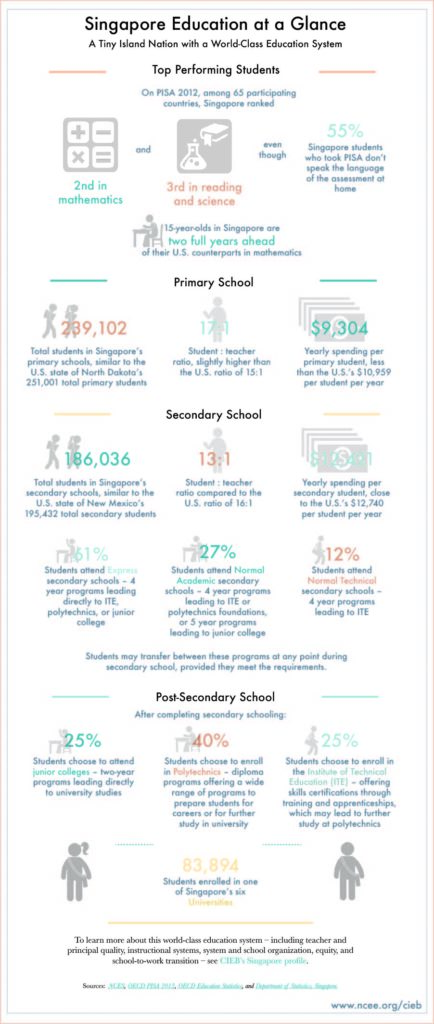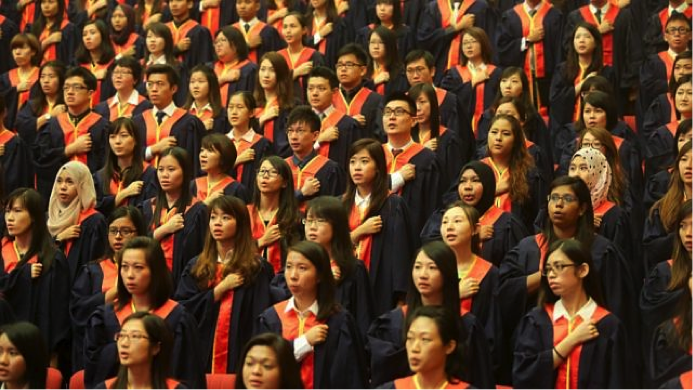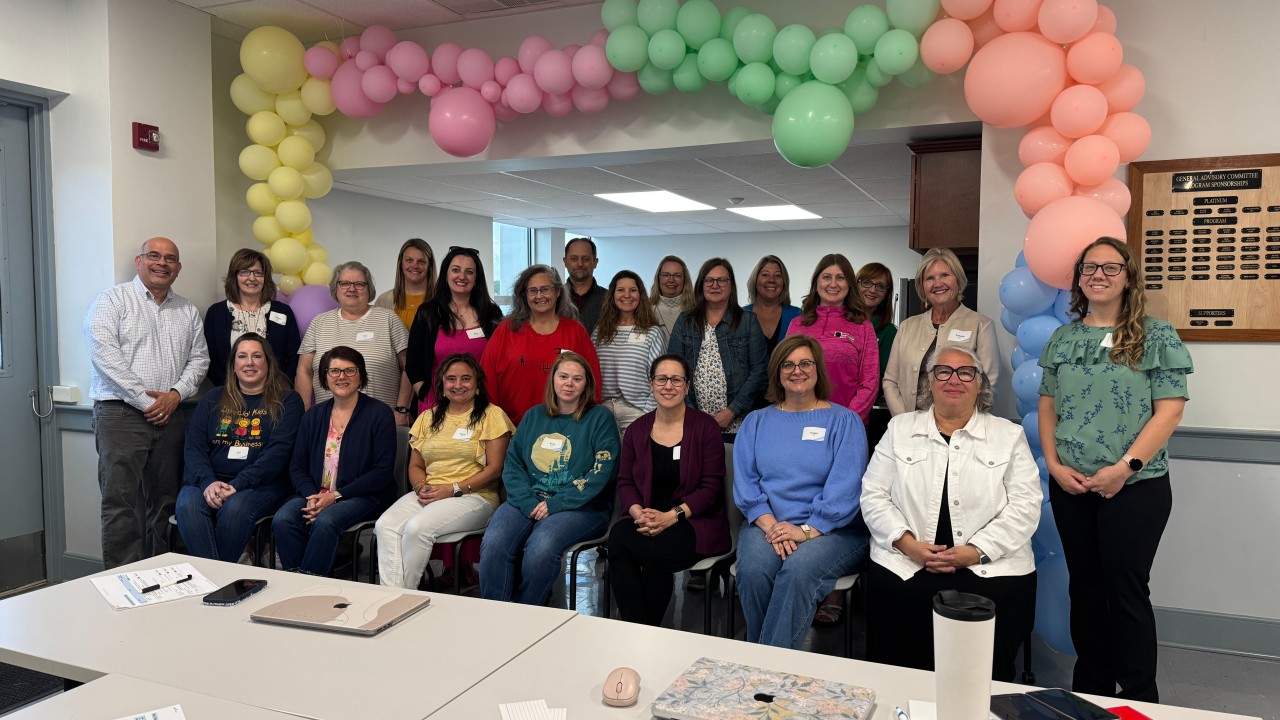By Nathan Driskell

“In the past, many of our students had dropped out of school because they couldn’t cope,” Professor Sing Kong Lee told CIEB researchers during a recent benchmarking trip to Singapore. “Now, with the implementation of the streaming system, they feel less stigmatized.” To an American audience, the statement was controversial – to put it mildly. Wasn’t the streaming system no different from the much-maligned tracking system that Americans had been wise enough to gradually phase out over the last decade? Hadn’t that system condemned thousands of American students to a subpar education? How could a system even remotely resembling that make students feel less stigmatized?
In Singapore, streaming – the practice of differentiating education for students based on their results on assessments at several key gateways – is thought of not as a way to segregate the most challenged students and make teaching classes more manageable. Instead, it reflects the philosophy that students who falter should neither be automatically promoted to do work they are unprepared for, nor should they be repeatedly held back and then labeled a failure until they drop out. Instead, all students should have access to an education that is tailored to their needs and interests and that they find rewarding and fulfilling. In fact, this approach sounds much like the calls for more personalized learning in the United States. In Singapore, this strategy is part and parcel of a commitment to ensuring that all students finish a challenging curriculum and are prepared to contribute to society and the world of work.
Using a system of streaming that helps students to identify what pace and type of experience is most engaging to them gives these students the tools to move between pathways if needed and never falters on its commitment to giving all students a rigorous and challenging education. As a result, Singapore has ensured that all of its students will complete school and learn at world-class levels. And we can see that in the latest PISA results. This Global Perspectives will explore the implementation of this system in more detail, looking closely at the features that enable it to function as well as it does.
Streaming System Structure
How does the streaming system come into play during the course of a student’s time in school? The compulsory education system consists of six years of primary school, four years of secondary school, and between one and three years of post-secondary school. Standards, curriculum frameworks, and assessments are centrally developed and aligned with one another and all teachers are trained to teach this curriculum. The curriculum includes: English; mother tongue language; mathematics; science; literature; history; geography; arts, crafts and design; and technology and home economics.

But this does not mean that all students have the same exact experiences in school. Students are placed into different pathways twice during compulsory education: first, midway through primary school, when it determines the pace of their coursework in the core subjects and later, at the end of primary school, when it determines in which of four pathways students will be placed. So students take common subjects, but at a different pace or using a different learning style that meets individual needs.
At the end of Year 4 in primary school, students take tests to determine the courses they will take in English, mathematics, mother tongue (a required course of study for all students, based on the language they speak in the home), and science. At the end of primary school, when students are about 12 years old, they take the Primary School Leaving Examination (PSLE) in English, mathematics, mother tongue, and science. Based on these results, students are admitted to one of four pathways in secondary school. Students take four exams, in their native language, English, mathematics, and science. Each exam takes two hours and fifteen minutes to complete, with the exception of English. The English exam is 3 hours and 45 minutes, requiring several 150-word open-ended answers, a multiple-choice test of grammar, vocabulary, and listening comprehension, and a five-minute oral assessment with an examiner on an open-ended topic. The math exam, too, is only about 20 percent multiple-choice, with the majority of questions requiring students to show how they arrived at the answers to multiple-step problems.
Their exam scores help determine what band students will be streamed into in lower secondary education. It also is weighed in the determination of which school they will attend. Students can request that their examination scores are sent to up to six lower secondary schools, which choose their students based on their PSLE scores. The Ministry of Education helps to place students who are not accepted into their schools of choice. The Ministry also allows some schools to practice Direct School Admission, admitting students based on their achievements in extracurriculars and their specified interests, in order to foster more robust school offerings in subjects such as sports and the arts.
Based on the results of their exam scores, students are placed in one of four pathways for lower secondary:
- Special
- Express
- Normal academic
- Normal technical
In general, the special track, comprising about 10 percent of students, is an accelerated pathway to university. About 50 percent of students are in the express track, which may directly lead to university, or first to junior college for an interim. About 20 percent pursue the normal academic track leading to a polytechnic institute (a form of vocational study), while another 20 percent pursue the normal technical track, which leads to a qualification at the Institute of Technical Education. All pathways are porous, and students can and do transfer between them frequently – including proceeding to university from the technical stream. Students and parents can request a transfer out of their current pathway, and the Ministry will approve the transfer provided that teachers and principals approve and can vouch for the student’s fitness for the new pathway. The expectation is that all students study at a pace and using a learning style (more theoretical or more applied) that makes them most comfortable.
Lessons for Implementation
As we learned more about how the streaming system functioned, several key themes emerged for U.S. policymakers seeking to implement such a system.
All streams preserve the same rigor in the core subjects. This is the most important feature of the streaming system and Singapore’s education system as a whole. Singapore’s system of streaming succeeds because it is supported by a world-class instructional system. Regardless of the path students take, they will be asked to meet a common set of very high standards in the core subjects, tied to a curriculum framework that all teachers are expert in teaching. Teachers will be expert in this because they have been trained in how to teach the curriculum, not in general theories of pedagogy divorced from the realities of the classroom. It is this instructional system that ensures that no student receives a lesser education. Again and again, policymakers and teachers stressed how important that is to them: there is no compromising on this point.

Different pathways are not stigmatized. Everyone we interviewed about streaming, from Ministry staff to principals to teachers, stressed that the names of streams were critical. Students are not “basic” and “advanced. The “normal” students are accomplishing exactly what they need to do to be successful. “Express” and “special” students are too – just at accelerated paces and in different ways tailored to keep them engaged. Students in these tracks are expected to learn the material more quickly to remain on the faster path to university, but this is seen as a strategy to keep them engaged, not a push to force them to achieve. “Technical” students are learning highly advanced skills that will ensure that they have rewarding careers. In fact, the technical pathway is so attractive that roughly 40 percent of students pursue technical qualifications of some form (either at a polytechnic or the Institute of Technical Education) after graduating from secondary school. All in all, students and policymakers are encouraged to see accelerated paths and academic & technical pathways as different routes to fulfilling lives in society.
Streaming is not fixed and students can and do move across pathways when they want to do so. According to our interviews with Ministry of Education staff, about 15 percent of students cross streams each year. This is facilitated by a move to more subject-based banding. If a student falls behind in a specific subject, then they may take that subject in a different stream to explore whether that pace works for them. And if a student in the normal academic stream is rapidly demonstrating promise in one subject, they may be moved into an express course in that subject to explore whether that pathway might be a good fit for them in the future.
Singapore’s world-class outcomes show that such a strategy works. Singapore’s secondary school completion rate was 99 percent in 2015. For school year 2014-2015, the United States’ average graduation rate was 83.2 percent, falling to 76.1 percent among low-income students and 74.6 percent among African Americans. And on the 2015 administration of PISA, the mean mathematics of the Singaporean student at the 25th percentile – a student from the lowest quartile of achievement – was 500, 30 points higher than the average score of all American students. In other words, the lowest-achieving students are learning more math and are better able to apply it to real world problems than the average American student. And, as we heard from policymakers and educators across the Singaporean system, streaming is a cornerstone of their strategy to ensure that educational attainment and achievement is available to all students across their society.




